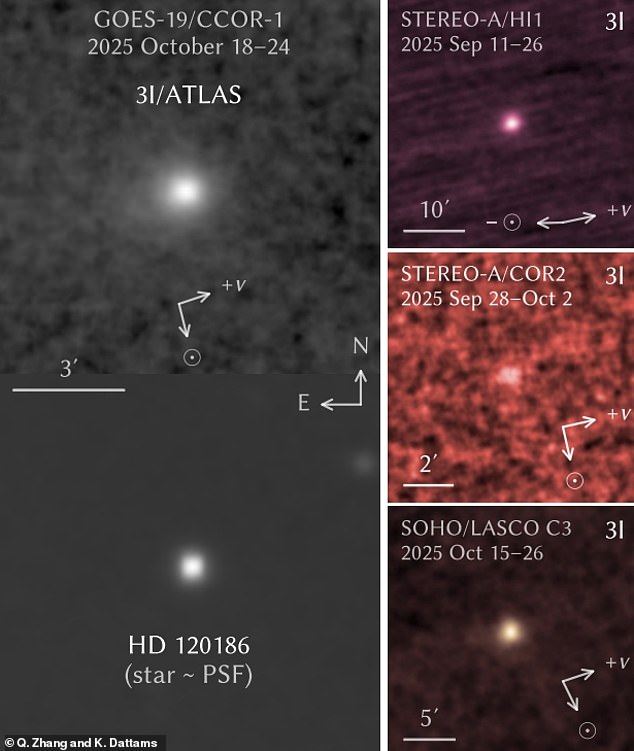The mysterious interstellar visitor 3I/ATLAS has emerged from behind the sun, now glowing in a way that has left scientists stunned.
The object made its closest approach to the sun on Wednesday, observed by three NASA spacecraft.
Data showed that 3I/ATLAS brightened at a rate about seven times faster than typical comets as it reached perihelion on October 29.
In other words, its light was increasing at an unusually rapid pace as it neared the sun.
Researchers involved with the observations published the study on Wednesday, saying: ‘The reason for 3I/ATLAS’s rapid brightening, which far exceeds the brightening rate of most Oort cloud comets at similar distances from the sun, remains unclear.’
Even more puzzling, the interstellar visitor now appears bluer, a reversal from its previously reddish hue, suggesting something beyond simple reflection is at play.
However, the team speculated that the blue glow likely comes from gas emissions, including carbon molecules (C2) and other compounds, rather than just sunlight reflecting off dust.
This is a developing story… More updates to come.
The object made its closest approach to the sun on Wednesday, observed by three NASA spacecraft. Data showed that 3I/ATLAS brightened at a rate about seven times faster than typical comets as it reached perihelion on October 29
The study, conducted by researchers from the Lowell Observatory in Arizona and the US Naval Research Laboratory in Washington DC, pulled data from the STEREO‑A (Solar TErrestrial RElations Observatory) and SOHO (Solar and Heliospheric Observatory).
They also used the GOES‑19, a weather satellite carrying the CCOR‑1 coronagraph, which helped capture the comet’s brightness and color while it was hidden behind the Sun from Earth-based telescopes.
CCOR‑1 detected a glowing plume extending nearly 186,000 miles around the object, comparable to the carbon dioxide halo observed months earlier.
The GOES‑19 satellite revealed that 3I/ATLAS is enveloped in a huge, fuzzy coma, roughly half as wide as the full moon.
Ground-based telescopes had trouble observing 3I/ATLAS while it was very close to the sun, but radio observations were able to detect emissions from the comet, showing it was producing huge amounts of water-related molecules.
The production rate of these molecules increased sharply as the comet got closer to the sun, following a pattern similar to the rapid brightening seen in optical observations.
The comet is expected to return to visibility in twilight and night skies during November and December, allowing ground-based telescopes to study it in much greater detail.
Early analysis suggests 3I/ATLAS will emerge considerably brighter than before

In other words, its light was increasing at an unusually rapid pace as it neared the sun
Scientists still do not fully understand why it brightened so fast, but it may be related to unusual activity from gases like carbon dioxide (CO2) and water (H2O), or unique properties of the comet’s nucleus, such as its composition, shape, or structure.
Observations from spacecraft also show that 3I/ATLAS has a large, fuzzy coma about half the size of the full moon, and its light is distinctly bluer than the sun, likely due to gas emissions from molecules like C2 and Amino groups, rather than just reflected sunlight from dust.
Its brightness increased much faster than typical comets, with a measured rate far exceeding the standard for Oort cloud comets, and the post-perihelion behavior remains uncertain; it could continue brightening, level off, or fade quickly.


